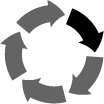Aligning Goals with Curriculum

Aligning program-level goals with the curriculum is a collaborative process for a department/program. At this stage, faculty members collectively determine where the department/program provides opportunities for students to acquire and practice the skills necessary for achieving the department/program’s learning goals. One commonly used method of gauging a program’s alignment with its learning goals is the curriculum mapping process.
Curriculum Mapping
Curriculum mapping assists faculty and staff in more carefully aligning instruction with desired goals and program-level outcomes. It can also be used to explore what is taught and how to better clarify for students where they are going, why they are going there, and what it takes to get there. Curriculum mapping relies on a matrix, essentially a table with one column for each learning goal and one row for each corresponding course or required experience in a specific department/program. The overall picture is useful in conceptualizing which levels of mastery and experience are expected at which parts of the course of study. Benefits of curriculum mapping include creating a unified program, improving communication among faculty, and increasing the likelihood that students meet stated program-level outcomes.
An example of curriculum mapping for a hypothetical Biology program (from the University of Hawai–Manoa’s assessment website, which also includes instructions for curriculum mapping):
Key: “I”=Introduced; “R”=reinforced and opportunity to practice; “M”=mastery at the senior or exit level; “A”=assessment evidence collected
| Courses | Apply the scientific method | Develop laboratory techniques | Diagram and explain major cellular processes | Awareness of careers and job opportunities in biological sciences |
| BIOL 101 | I | I | I | |
| BIOL 202 | R | R | I | |
| BIOL 303 | R | M, A | R | |
| BIOL 404 | M, A | M, A | R | |
| Other: Exit interview | A |
